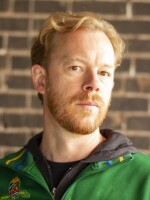Jack Baumgartner starts by showing off the land he tends. After sharing his joy of farming — all the way from the dung beetle to the heirloom machinery he uses and modifies to produce goods — he gives a tour of his workshop.
Baumgartner’s painting studio shares a roof with his wood shop. In this space, he creates music, furniture, prints, poems and many other creative pursuits to move his spirit. Inside is a well-kept but dusty woodshop. Behind it is a slightly smaller painting, music-making, and writing studio — with a still, very farm-like feel.
“They described it as spiritual technology, how the art was functioning in these contexts,” he said, “and that blew me away. I'm like, that's what I'm here for. That's what I'm interested in, doing something real by being a painting.”
This is the moment that locked Baumgartner in at the Kansas City Art Institute nearly 25 years ago: The realization that his painting allowed his spirit to travel.
“I just realized that's what was happening to me,” he said. “...I was going somewhere and I was experiencing something. Early on in school, I realized that I was painting these landscapes because I wanted to go there.”
Baumgartner has taken this feeling through stories of the bible — specifically this painting about a vision shared in the book of Zecharia.
“I've always sort of felt like a kinship with his visual language in this story,” he said.

After the Israelites return from Babylon and start rebuilding, Baumgartner’s painting depicts an angel taking Joshua to a council of heavenly beings.
“And the angel of the Lord is there, and Satan is there. And there's these other angels there,” he said. “Satan is accusing the high priest, his name is Joshua. He's basically saying ... it's imposter syndrome. I guess he's saying he's not fit to be the high priest.”
An angel commands that Joshua be put in clean clothes.
“And then there's — this always strikes me as kind of funny — Zechariah, who's watching with this angel from the side, shouts out, 'Put a clean turban on his head.’
“So there's [these] angels putting the turban on his head, and he's being wrapped. And then there's all this crazy stuff.”
Then there are the symbols of divine empowerment for rebuilding the temple.
“There's like a seven faceted stone that shows up,” Baumgartner said. “There's this lamp stand that's being fed by olive trees, like perpetually fed by olive trees. There's a stone that comes down out of the heavens, like a capstone.”

The story ends on a well-rooted connecting point for Baumgartner.
“The angel of the Lord says, ‘I'll remove the guilt of this land in one day.’ And it's just like one of those ... really deep relationships with soil and land, and a desire to see land restored.
You know, both from a physical, a health standpoint, but also from a spiritual. So that is a really strong statement.”
Baumgartner said his paintings are not about saying something.
“I don't even know if I'm trying to understand,” he said. “I'm just trying to listen.”
He has developed a character, like an avatar, to explore his work more deeply.
“So there's these three guys here,” he said. “One of them is the angel, one of them Zechariah. And the third one is a character called ‘walking man.’ He's sort of like an everyman/self-portrait character. I imagine that maybe walking man is there too and gets to witness this. Like, what if I got to witness this?”
Baumgartner’s painting is a way to manifest this vision that otherwise might lose its enormity through description alone.
“I feel like I'm maybe missing the point of this whole story if I try and solve it. All these things are ways of getting at something bigger than what we can describe. If we can just describe it like this, talking to each other, then ... well, surely we're not seeing big enough.”



